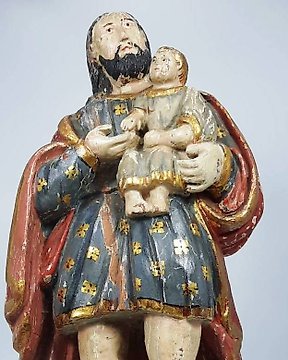
雕塑, Saint Santos - 16 cm - 木
编号 81626807

编号 81626807

Polychrome wooden sculpture of a putto with gilt curly hair and with closed eyes facing downwards, creating a subdued appearance. Exceptional quality woodcarving, the base has been painted to imitate a brown reddish marble, wich was a practise in the 17th and 18th century.
Presumably the sculpture was made in Central Europe, early 17th century, transition from Renaissance to early Baroque.
The polychromy has been renewed, base 19 x 16 cm.
Heigh: 75 cm.
Overall in good condition, some minor cracks in the polychromy.
Putto
A putto (Italian: [ˈputto]; plural putti [ˈputti]) is a figure in a work of art depicted as a chubby male child, usually naked and very often winged. Originally limited to profane passions in symbolism, the putto came to represent a sort of baby angel in religious art, often called cherubs (plural cherubim), though in traditional Christian theology a cherub is actually one of the most senior types of angel.
The more commonly found form putti is the plural of the Italian word putto. The Italian word comes from the Latin word putus, meaning "boy" or "child". Today, in Italian, putto means either toddler winged angel or, rarely, toddler boy.
Putti, in the ancient classical world of art, were winged infants that were believed to influence human lives. In Renaissance art, the form of the putto was derived in various ways including the Greek Eros or Roman Amor/Cupid, the god of love and companion of Aphrodite or Venus; the Roman, genius, a type of guardian spirit; or sometimes the Greek, daemon, a type of messenger spirit, being halfway between the realms of the human and the divine.
Putti are a classical motif found primarily on child sarcophagi of the 2nd century, where they are depicted fighting, dancing, participating in bacchic rites, playing sports, etc.
The putto disappeared during the Middle Ages and was revived during the Quattrocento. The revival of the figure of the putto is generally attributed to Donatello, in Florence, in the 1420s, although there are some earlier manifestations (for example the tomb of Ilaria del Carretto, sculpted by Jacopo della Quercia in Lucca). Since then, Donatello has been called the originator of the putto because of the contribution to art he made in restoring the classical form of putto. He gave putti a distinct character by infusing the form with Christian meanings and using it in new contexts such as musician angels. Putti also began to feature in works showing figures from classical mythology, which became popular in the same period.
Some of Donatello's putti are rather older than the usual toddler type, and also behaving in a less than angelic way. The bronze figure of Amore-Attis is the most extreme of these. These are often termed spiritelli, sometimes translated as "imps". Older putto-like figures are seen in other art; they are very typical as winged teenage boys in the borders of works by the Embriachi workshop from the years around 1400.
Most Renaissance putti are essentially decorative and they ornament both religious and secular works, without usually taking any actual part in the events depicted in narrative paintings. There are two popular forms of the putto as the main subject of a work of art in 16th-century Italian Renaissance art: the sleeping putto and the standing putto with an animal or other object.
Putti, cupids, and angels can be found in both religious and secular art from the 1420s in Italy, the turn of the 16th century in the Netherlands and Germany, the Mannerist period and late Renaissance in France, and throughout Baroque ceiling frescoes. Many artists have depicted them, but among the best-known are the sculptor Donatello and the painter Raphael. The two relaxed and curious putti who appear at the foot of Raphael's Sistine Madonna are often reproduced.
They also experienced a major revival in the 19th century, where they gamboled through paintings by French academic painters, from advertisements to Gustave Doré’s illustrations for Orlando Furioso.
The iconography of putti is deliberately unfixed, so that it is difficult to tell the difference between putti, cupids, and various forms of angels. They have no unique, immediately identifiable attributes, so that putti may have many meanings and roles in the context of art.
Some of the more common associations are:
Associations with Aphrodite, and so with romantic—or erotic—love
Associations with Heaven
Associations with peace, prosperity, mirth, and leisure
The same figures were also seen in representations of classical myth, and increasingly in general decorative art. In Baroque art the putto came to represent the omnipresence of God. A putto representing a cupid is also called an amorino (plural amorini) or amoretto (plural amoretti).
(Wikipedia)